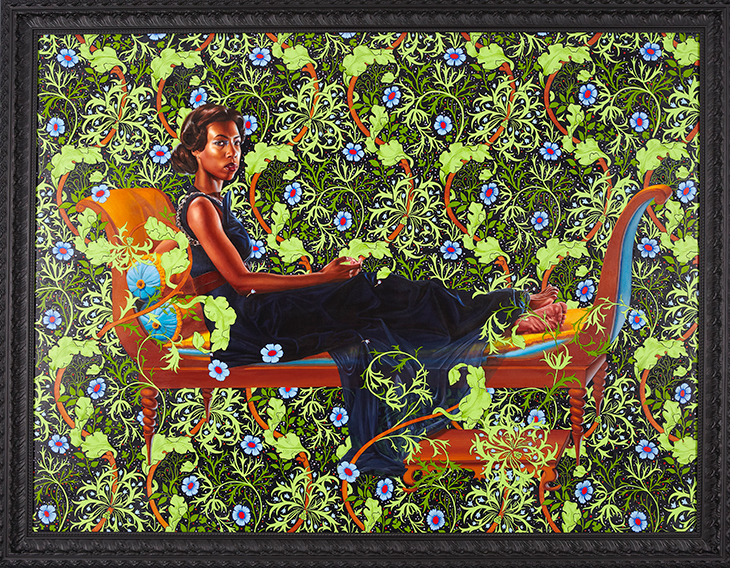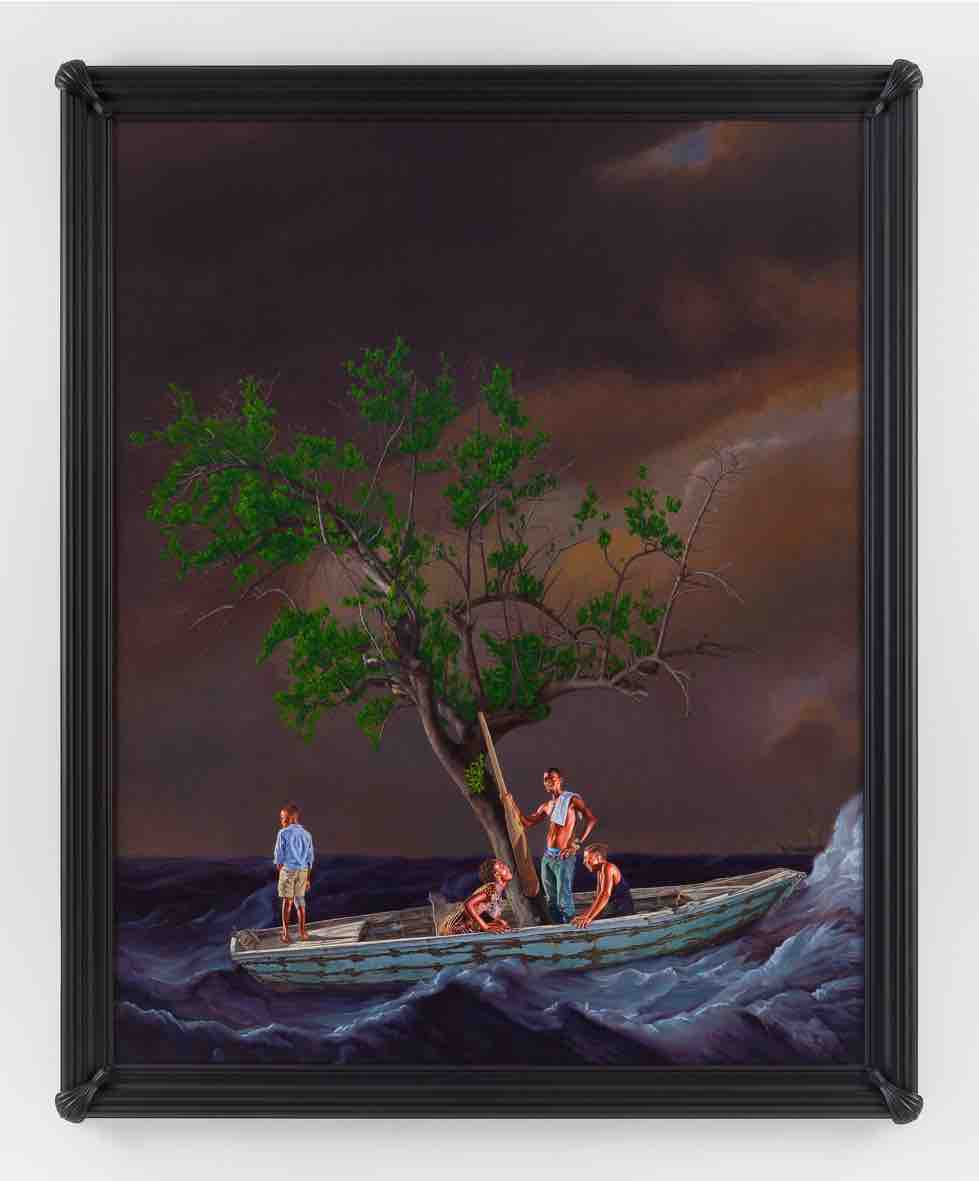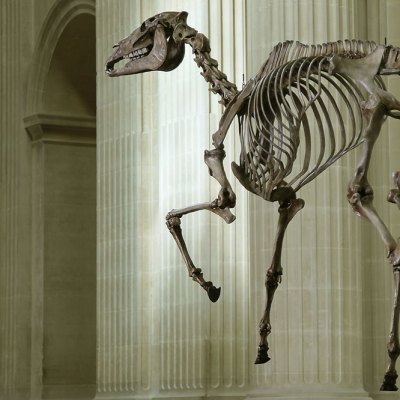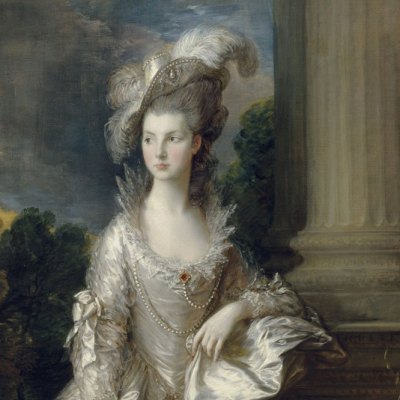Kehinde Wiley
Emily Raboteau talks to the artist about painting portraits in the Grand Manner – and his recent turn to landscapes
The twin peacocks painted on the chartreuse wall behind the gilded bar in the club room of the Soho Grand Hotel in Manhattan look like the background of a Kehinde Wiley painting. Against this backdrop of outrageous feathers and dazzling green I sit down with the artist, one morning in September, to talk about his work. In one corner of the room, three assistants gather over cell phones to book Wiley’s next flight to Europe. In another, a dresser unzips a garment bag full of jackets for Wiley to choose from for the photo shoot to accompany this profile; blazers custom-made from West African textiles, some with satin lapels, plus a glossy bomber jacket for good measure, printed, coincidentally, with peacocks. Everything about this scene, including the fact that Wiley has attended MTV’s Video Music Awards the night before – having redesigned the award statuette on the occasion of the network’s 40th anniversary – conveys that I am in the presence of a celebrity. Yet the painter surprises me by describing himself as an introvert. ‘I’d rather be in the studio, painting,’ he says.
Wiley is arguably the most prominent visual artist of his generation. He is best known for the exuberant photorealistic portraits of young Black and brown men in heroic poses that he’s been painting for the last 20 years, and for the technical skill with which he renders dark skin. His oeuvre raises questions about power, privilege and identity, and redresses the absence of central Black figures within European art. He counts Titian, Tiepolo, Van Dyck and Sargent among his influences. A Wiley canvas is instantly recognisable, typically framing its subject in a re-enactment of an Old Master painting – but clad in urban streetwear, and set against an ornately patterned decorative background drawing from sources as varied as Islamic architecture, Victorian wallpaper, and Renaissance tapestries. A classic example is his painting Napoleon Leading the Army over the Alps (2005), which imitates Jacques-Louis David’s famous portrait, substituting Napoleon’s figure with an unnamed African American sitter clad in Timberland boots and camo fatigues, astride a horse in front of a Rococo-style scrim. In a culture that refuses to stop criminalising Black men, a Wiley portrait scans like the opposite of a mugshot. That is, the paintings are embodiments of beauty, confidence and nobility, reflecting the desire to have Black subjects acknowledged as contributors to world history.
Napoleon Leading the Army over the Alps (2005), Kehinde Wiley. Brooklyn Museum. © Kehinde Wiley

‘Imbedded within “The Museum”,’ says Wiley, ‘is a lot of domination, cultural insistence that this is the best way it could ever be. […] If that is in fact the case then there’s a large part that’s missing. And so my work has made a concerted effort to correct for our blind spots collectively but it’s also encapsulating a set of twin desires, a love affair with Western painting and a desire to continue the material practice of painting but to allow for a broader understanding of what it means to paint skin, and what it means to explore colour in relationship to identity.’
Wiley’s usual process, which began in 2001 in New York during a residency at the Studio Museum in Harlem, is to work from photographs of people he meets on the street. His models are his collaborators; together they choose from art-history books the image they’ll remix. In 2006, Wiley began expanding both his geographical range and the size of his canvases to include models from around the world, from cities including Mumbai, Rio de Janeiro, Senegal, Lagos, and Dakar, in an ongoing series called The World Stage, of portraits imitating Maoist propaganda posters. ‘As I’ve been travelling, I started to notice that the way many people in other parts of the world interact with American culture is through Black American expression.’
On occasion, the artist has taken commissions to paint famous people, such as Michael Jackson, Spike Lee, and the Notorious B.I.G. His presidential portrait of Barack Obama against a botanical backdrop, finished in 2018 and now touring the United States before returning to the Smithsonian’s National Portrait Gallery (currently at LACMA, until 2 January 2022), has introduced all of America to Wiley’s signature style. At my house in the Bronx, we eat Thanksgiving dinner off a set of porcelain collectors’ plates printed with faces from Kehinde Wiley portraits from 2008–12. Now entering the third decade of his career, the artist is preparing for a new exhibition, ‘The Prelude’, which opens this month at the National Gallery in London (10 December–18 April 2022).
Juliette Recamier (2012), Kehinde Wiley. © Kehinde Wiley

I ask Wiley what he thinks about the fact that for a younger generation who might view his work in museums before seeing the historic paintings to which it alludes, he has succeeded in reshaping the canon. My Black eight-year-old transgender son, for example, has not yet encountered Gauguin’s exoticised nude portraits of young Tahitian girls the artist had sex with and referred to as ‘savages’. But he has seen Wiley’s series of the Mahu (a non-binary community considered third-gender in Polynesia), painted in Tahiti and modelled after Gauguin.
‘That is fascinating,’ Wiley says, breaking out a bright gap-toothed smile. ‘Especially in the age of Google where you could literally search the title of some of these famous works that I’m quoting and my work might possibly be the first interface that you have with it. […] There’s a whole generation of kids for whom their first American presidency was occupied by a Black man and it’s only later that they have to address what came before that.’
Like Obama, Wiley is the son of an African father who came to the United States as a first-generation college student on a scholarship, and a resourceful American mother who was ambitious for her children. Wiley was born in 1977, the fifth of six children, and grew up poor in South Central Los Angeles without knowing or even possessing a picture of his father, Isaiah D. Obot, who returned to Nigeria. His mother, Freddie Mae Wiley, ran a thrift shop and was committed to getting her kids ‘out of the hood’. She enrolled Kehinde and his twin brother, Taiwo, in weekend art classes at a conservatory when they were 11, and at 12 in a summer programme in the Soviet Union organised by the Center for US–USSR Initiatives, where he studied art and the Russian language. In 1992, the LA Riots set the city aflame due to long-smouldering racial tension, sparked by police brutality. ‘I know how young Black men are seen,’ he says. ‘They’re boys, scared little boys. Oftentimes, I was one of them. I was completely afraid of the Los Angeles Police Department.’
Portrait of a Young Gentleman (2021), Kehinde Wiley. Huntington Library, Art Museum and Botanical Gardens. © Kehinde Wiley

Wiley took refuge in museums. At the Huntington, he was drawn to Thomas Gainsborough’s The Blue Boy (c. 1770), representing a cocky adolescent about his own age. Earlier this year, the Huntington commissioned a response to that portrait from Wiley. In October, A Portrait of a Young Gentleman hung in homage-cum-faceoff with The Blue Boy on the opposite gallery wall. (Another notable museum acquisition this year is by the V&A, of Portrait of Melissa Thompson) At the Los Angeles County Museum of Art, he also felt inspired by Kerry James Marshall’s grand barbershop painting De Style (1993), recognising himself in its cultural setting, but – as he has said elsewhere – felt ‘it was thrown into very sharp relief when thinking about the absence of other Black images in that museum’. Later on, as a graduate student on scholarship at the Yale School of Art, he talked to Marshall about craft. ‘He was mentioning that the way you paint something and the way you feel about something are so tightly entwined. “Do you paint a feather the same way you paint a brick? Is it possible to paint a brick feather-like?”’
After earning his MFA from Yale in 2001, Wiley immediately began his residency at the Studio Museum. A found object on a Harlem Street set him on a new course. It was a crumpled-up mug shot. He began thinking about the mug shot as portraiture, and pinned it on his studio wall. ‘What is portraiture?’ he asks. ‘It’s choice. It’s the ability to position your body in the world for the world to celebrate you on your own terms.’ Conversely, a mug shot allows the sitter no choice about how he is presented. Wiley experimented with paintings based on mug shots, including the one he’d found, wondering whether portraiture has the power to communicate anything deeper, more spiritual, than the sitter’s physical traits.
It’s not just the political performance at play in Wiley’s extravagant bid for legitimacy that fascinates me; it’s the psychological aspect. ‘The stuff I do is a type of long-form autobiography, but the starting place is not me,’ Wiley said in an interview with the New York Times around the time of his show at the Brooklyn Museum in 2015. I ask him to elaborate on this. ‘There’s a sort of desperation that starts at the age of 18 where I jump on a plane looking for my father, and everyone thinks I’m just mad,’ he recollects. ‘And I think there’s a sense then of a continuing longing to be a part of Africa, to have an uncontested relationship not only with the continent but to my father and to the people who gave rise to me. So there’s something broken in there and there’s a certain sadness that surrounds it, but I think much like many of my paintings, it’s kind of a gilded sadness.’
Some of Wiley’s more recent work depicts armour. He’s interested in its power to both conceal and reveal. Regarding his portrait of Michael Jackson in body armour, Wiley says, ‘It’s holding something in and locking something out at once. [Jackson] was talking about his career and how that celebrity thing he built is a kind of armour but that also lays him vulnerable. It’s an interesting psychological space.’
I wonder if street casting has grown more difficult for him now that everyone’s wearing face masks in this, our pandemic era. Is he stymied by such wholesale concealment of the human face or has he incorporated mask fashion into his ongoing project? He says he isn’t interested in referencing it. ‘I just feel like it’s going to have a shelf life. There will be a point at which it won’t be legible. I do seek a kind of timelessness in my work, although decay is a really important part of fashion, too. You know, looking at an old Frans Hals and seeing these insanely ornate neckpieces or looking at a Van Dyck and some of those over-the-top gowns and pearls and lap dogs. […] I do enjoy that but don’t think that the mask is something I can quite wrap my head around now.’
Nevertheless, the pandemic has changed his process. ‘It’s caused me to have a much smaller set of variables to work with. I can’t leave the house. I can’t shoot far-flung places. But I can slow down and paint the people who are immediately around me. I can paint at a much slower pace. Fewer studio assistants. A less fussy way of painting. […] When I look at the pandemic paintings, there’s a kind of interesting re-centring. Like when people get married again just to renew their vows. And also to return to some of the principles that got me where I am. I started going back to some of the work that I was doing in graduate school, picking up where I left off.’
Conspicuous Fraud Series #1 (2001), Kehinde Wiley. The Studio Museum in Harlem. © Kehinde Wiley

For example, ‘The last painting that I did in graduate school was the piece that the Studio Museum ended up acquiring, which had this sort of impossibly large totemic hair that, like Medusa, takes over the entire space – with this kind of Tiffany green. It was actually Martha Stewart’s 1999 home collection, “sea-foam green”,’ he says, referring to Conspicuous Fraud Series #1 (Eminence) of 2001. ‘I was trying to make these interesting class associations with colour, race, Samsonian notions of hair and strength and virility. So anyway, I ended up revisiting that but this time through epic works on paper, watercolours.’ The last couple of years seem to have been no less a productive time for the prolific artist than pre-pandemic.
As for his exhibition in London, Wiley will shift his focus from one European tradition – Grand Manner portraiture – to another: landscape painting. Through new artworks, painting and film, Wiley will look at European Romanticism and its focus on epic scenes of oceans and mountains, rhyming with the National Gallery’s collection of historical landscapes and seascapes by Turner, Claude, Vernet and Friedrich.
‘I cast [the models] in London – important that they be from London because the show is in London – all African in ancestry, and I flew them to the fjords of Norway where we have these incredibly gorgeous sheer white cliffs and their Black skin against these sharp white backgrounds. So those are the paintings, and then the film is also shot there because it’s just heartbreakingly beautiful cinematographically. I’m fusing that with an earlier conversation that I had about the sea in which we had subjects that were cast in a small island off the coast of Haiti.’
Ship of Fools (2017), Kehinde WIley. Royal Museums Greenwich, London. Courtesy the artist, Stephen Friedman Gallery; © Kehinde Wiley

One of Wiley’s seascapes, Ship of Fools (2017), is a large oil painting depicting migrants in a rickety boat with a tree trunk growing where the mast would be, responding to Hieronymus Bosch’s panel of the same name in the Louvre. In Wiley’s scene, a group of Black men at sea struggle to reach the land – an allegory for historical and contemporary experiences of migration.
‘I basically wanted to look at migration and the sea – but also Turner paintings and the sea, the whole tradition of ocean paintings and romanticism surrounding the ocean; the same way in which we look at mountainscapes and seascapes and have a racial understanding of what they mean culturally. I wanted to look at madness and Fanon’s notion of the ways in which the colonial project can literally drive you mad.’
We speak briefly about the crosscurrents of madness and bravery that have sent many African American citizens on reverse migrations, driven by dispossession, disenfranchisement and disinheritance to find a home elsewhere. (This was the subject of my last book, Searching for Zion, which I would describe as Wiley describes his project – as an autobiography of others. It featured a Kehinde Wiley portrait of a Black Israeli on the paperback cover.) Wiley says, ‘I use the metaphor as a way of understanding the ocean and the sense of being swallowed up by something […] a sense of fear and danger in the colonial project.’
The spare white mountain background of a film still from In Search of the Miraculous (2021) and the darker, more earthy tones of the seascape paintings are a far cry from the vivid filigree in the flat fields of Wiley’s earlier portraiture. The posture of bling is gone. I ask the artist if he is still painting himself. ‘I am. I’m doing pointing, I’m doing looking. It’s this body travelling through the world encountering others, being excited by certain things, and ignoring other things. Does art do more than point? Of course it does. What I’m doing is holding a mirror up to myself and the world at once. That’s what I’m trying to do.’
Kehinde Wiley photographed by Kyle Dorosz in New York in September 2021. Photo: © Kyle Dorosz

Emily Raboteau is a New York-based art critic, street photographer, and essayist.
‘The Prelude’ is at the National Gallery, London, from 10 December–18 April 2022.
The Winners | Personality of the Year | Artist of the Year | Museum Opening of the Year | Exhibition of the Year | Book of the Year | Digital Innovation of the Year | Acquisition of the Year | View the shortlists



